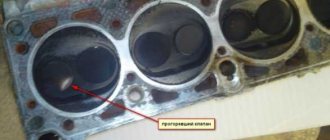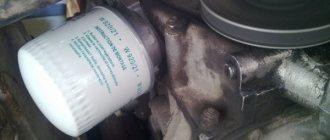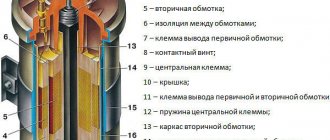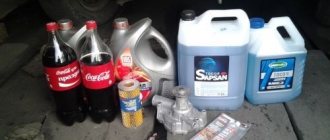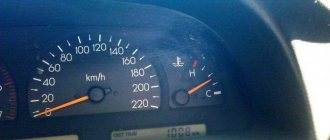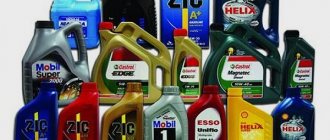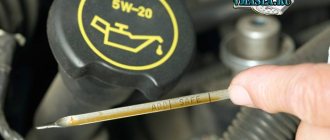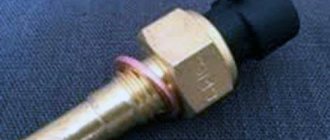Where does water come from in the gas tank?
If only gasoline is poured into the tank, where can the water come from? In fact, there are several sources due to which liquid enters the tank:
- Condensation is the most common cause. The tank is not completely filled with fuel, so part of the space will be empty, i.e. there is air there. You remember from physics lessons that moisture in the air can condense. When temperatures change, small drops gradually accumulate on the inner walls of the tank and flow into the gasoline.
- Precipitation. Every driver has refueled at least once in the rain or snow. Drops or snowflakes quickly enter the gas tank. In 1 year, precipitation can accumulate from 30 to 70 milliliters of water.
- Petrol. Water may end up in the gas station storage area. When purchasing fuel from canisters from third-party sellers, be especially vigilant, because it will not be difficult for them to dilute gasoline with water.
On average, about 100-150 milliliters of water can enter the tank per year. How dangerous this is will be discussed below.
Water in the gas tank is bad
Do not underestimate the danger of a couple of hundred milliliters of water. Firstly, metal tanks can simply rust. In this regard, fuel leakage and expensive replacement of the entire component are guaranteed. Secondly, fuel deposits suffer. On most cars it is installed inside the fuel tank. Its design allows you to “suck” only gasoline through a special mesh. Water accumulates on it, and icing occurs in cold weather. The mesh becomes clogged, the fuel supply is disrupted, and the pump operates under increased loads (even to the point of complete breakdown). On some vehicles, the fluid may travel further than the pump through the fuel line to the engine. When water freezes, a blockage forms on the way to the engine.
If you don't want to change the fuel pump or worry about corrosion, then be sure to pay attention to this problem. To do this, you need to figure out how to get rid of water in the gas tank.
How to get rid of water
There are several ways to fix the problem:
- If there is a drain at the bottom of the gas tank, then the correct thing to do is to completely drain the fuel along with any moisture it contains, and then let the gas tank dry.
- A hose is inserted into the tank at one end, and the other into any container below its level. The easiest way to do this is on an overpass.
- To completely clean the tank, you will have to dismantle it. This is a complex but most reliable procedure. The contents will be completely cleared not only of water, but also of various debris that harms the operation of the fuel system.
- You can pump out water using a pump. Remove the fuel supply hose to the injector from the fuel pump. A separate hose is put on the spool and the other end is placed in any container. After this, the ignition is turned on and fuel is pumped out of the tank. Option only for injection cars.
- Contact the service station. This is a quick and inexpensive procedure.
- You can buy special products (additives) that are added to fuel to remove water from it.
- In the fall, pour up to 500 ml of ethyl alcohol into an empty tank, and then fill it to the very top to push out the air.
- For diesel engines, use a mixture of engine oil plus diesel fuel in a ratio of 0.5 l/50 l, respectively. Engine oil is mixed with water to form a special mixture that burns normally in the engine.
How to remove water mechanically
The first and most primitive method of removing water from a gas tank is to remove it mechanically. You can try to drain the fuel through a hose or dripper, but at least a few drops will definitely remain at the bottom. It will be more effective to dismantle the tank and then clean it manually. The method gives 100% results, but it is extremely labor-intensive. Not every driver will be able to remove this part, not to mention the need to spend valuable time.
It is permissible to use the mechanical method when other methods and special means do not give a positive result. Please note that after flushing it is recommended to fill the tank full, but try to always keep it full. This will prevent the formation of condensation, but will significantly hit your pocket.
How to remove water from a gas tank using alcohol, acetone, solvent
A simple and cheap folk method for removing water from a gas tank is to use alcohol, acetone or solvent. Here it is necessary to delve a little deeper into the school chemistry course. Water has a higher density than gasoline, so it “settles” at the bottom. This is the main reason why removing it is problematic.
Alcohols such as ethyl (common medical), methyl (poisonous) and isopropyl are close in density to water, so they can mix well. This also applies to acetone with solvent. This mixture becomes flammable, enters the fuel pump, engine and burns perfectly, leaving along with the exhaust gases. However, keep in mind that alcohol also raises all the sediment that has accumulated inside for many years. It is also recommended to check the condition of the fuel filter. If necessary, you need to change it.
Motorists recommend pouring 250-500 milliliters of alcohol/acetone into a 40-liter gas tank. Considering the low cost of acetone, you can perform the cleaning procedure at any time. Problems can only arise with the purchase of alcohol.
How to remove moisture from a gas tank?
Moisture can form in the fuel tank of every vehicle for various reasons.
As practice shows, most often this occurs due to condensation. If water gets into the engine, it can damage the injectors, which will affect the operation of the vehicle and may require serious repair work. To prevent this, you should pay attention to this problem, and if moisture accumulates, you can remove it from the tank yourself, without the help of automotive service employees.
The procedure for removing water from a gas tank is quite simple, and therefore does not require additional effort from the driver or contacting dealerships, which will charge a considerable fee for it.
Cause. Most often, drivers encounter this problem in the winter. The thing is that temperature changes lead to condensation of vapors, which can contribute to complete failure of the injector. Also, a similar problem can occur if the driver fills the tank with little fuel, which leads to the appearance of air.
During movement, the air condenses and this leads to the formation of moisture. That is why manufacturers advise, whenever possible, to refuel a full tank, regularly visiting gas stations and not operating a car with a half-empty tank.
Another reason for the appearance of water in the gas tank is the use of low-quality fuel, but in recent years, drivers may encounter this less and less because, as a rule, the gasoline offered at gas stations meets certain standards.
Why is water in fuel dangerous? Water formed in the fuel can freeze during the cold season, after which it enters the fuel pump and disables it. In this case, drivers must be prepared for an expensive and labor-intensive repair process. There is also a danger in the fact that frozen water can get into the fuel line, which will lead to problems with starting the engine or its complete failure.
Removing water. Today there is one proven method that can help remove water from the tank. To do this, the owner can pour alcohol into the tank or use specialized auto chemicals to combat the appearance of moisture. Most car specialists assure that this is absolutely safe for the operation of the car.
To use alcohol for a gas tank, you need to mix it with gasoline at the rate of 50 liters of fuel for 500 milliliters of alcohol. This ratio is absolutely safe for the car and will allow the driver to operate it without breakdowns.
Bottom line. There are proven ways to combat the appearance of water in the fuel tank. Whichever method drivers use, they must understand that it is extremely important to do everything as indicated in the instructions. So, the same alcohol can be used only according to the permitted standards and nothing else. Otherwise, drivers themselves will contribute to a number of problems with the car. If you are not sure that you can handle it yourself, trust the professionals at the service station.
- The American Dream remains a reality. Cadillac introduced new crossovers
See all photo news >>
How to remove water from a tank using store-bought products
If you are afraid that acetone will destroy system components or do not trust the solvent, you can buy a product to remove water from the gas tank. A typical example is the Lavr winter fuel dryer. This is a special additive for removing water from a gas tank, the cost of which varies between several hundred rubles. The product contains:
- aliphatic alcohol;
- base aliphatic solvent;
- glycol ether;
- functional surfactants.
The method of application is similar to alcohol: the composition should be added to gasoline in the tank, taking into account several features. Experts recommend burning the maximum amount of fuel before use. The “Lavr” spray can is designed for a tank with a volume of up to 60 liters. Can be used not only in gasoline, but also diesel cars.
The cost of such products is relatively low (usually up to 300 rubles). You can find a lot of analogues on the market. Before purchasing, be sure to read the ingredients and make sure you haven’t stumbled upon a fake.
Additionally, drivers can use other auxiliary attachments:
- Fuel saving additives. Added to gasoline. According to the developers, they reduce consumption by approximately 10% by cleaning the engine. In practice, indicators may differ from those stated.
- Dehydrogenating additives. They are used at low temperatures, preventing gasoline from freezing.
- Stabilizing additives. They are added to engine oil and regulate the composition of exhaust gases.
- Antifriction or restoration additives. They are used to remove carbon deposits.
When using several additives at the same time, make sure that they do not react chemically with each other.
Methods for removing water from a gas tank
Water should be removed from the fuel tank before starting the engine. To do this, you can either use special chemical compounds or do without them.
Mechanical removal of water from the gas tank
The following methods are most often used.
- Removing the gas tank. In this case, the water is guaranteed to be completely removed. The tank is removed from the car, emptied of its contents and dried. However, this method is quite labor-intensive.
To completely remove condensation, you must remove the gas tank from the car.
- Communicating vessels method. One end of the long hose goes down to the bottom of the gas tank, and the other end goes into any container located below the level of the tank. To speed up the process, you can drive the car onto a lift, overpass or inspection hole.
- Pumping out. The gasoline supply hose to the injector is removed from the pump, usually located under the rear seats. The second hose is put on the spool and placed in an empty container. Then the ignition is turned on and the electric pump begins to pump liquid out of the tank. This method is only relevant for injection cars.
Article on the topic: What is the difference between 95 gasoline and 92
Removing water using special means
You can clean the fuel tank from moisture using special chemicals.
- There are chemicals that bind water when added to the tank. It is effective, but not entirely safe. The water still remains in the tank, albeit in a different state. Moreover, the effect of these agents on the engine has not been fully studied.
- For diesel engines, add 500 grams of engine oil to 50 liters of fuel. Water mixes with oil and the resulting emulsion burns.
- For gasoline engines, 200–500 ml of alcohol is poured into the tank. Water burns together with the combustible mixture. To implement this method, a high level of gasoline in the tank is required. At the same time, it is absolutely harmless to the fuel system. However, alcohol will raise sediment that has accumulated at the bottom of the tank. After this, the fuel filter should be changed. This technology should be used in the fall, before the first frost. In this case, the fuel system will not freeze.
You can use alcohol to remove water from your car's gas tank.
Use of additives
Additives added to oil or fuel are divided into four types:
- Fuel saving additives. They are added to gasoline and reduce its consumption by about 10% by cleaning the engine. The additive, along with the fuel, passes through the combustion chamber, valves and other components and cleans the power unit. These means are used when the machine is unstable at idle or when the engine power is insufficient.
Water can be removed from the gas tank using special additives
- Dehydrogenating additives. They are usually used at low temperatures, when the mixture of gasoline and water in the fuel system may freeze.
Dehydrogenating additives effectively remove water from the gas tank
- Stabilizing additives. They are added to engine oil and regulate the composition of exhaust gases. Such additives increase the viscosity of the oil at elevated temperatures, minimizing the amount of carbon monoxide in the exhaust, and are used only for preventive purposes.
Stabilizing additive makes vehicle emissions less harmful to the environment
- Antifriction or restoration additives. They are used for high mileage vehicles (more than 100 thousand km). By cleaning the internal surface of the engine from dirt, such additives restore cylinder walls and other components with minor scratches and cracks. As a result, compression increases.
Anti-friction additives stabilize engine performance
The attitude of car enthusiasts towards additives is ambiguous. In any case, it is better to try to prevent the “illness” of the car than to “treat” it with the help of additives.
Main brands of water removal additives
The following brands of additives are most popular among car owners.
- E.R. The additive is popular among owners of cars with high mileage. Its effectiveness has been confirmed by laboratory studies. This is a kind of “metal conditioner” that minimizes friction between individual components of the car. As a result of using ER, fuel consumption decreases, engine torque and power increases, the engine runs quieter and the mileage between oil changes increases. The advantages of ER include its low cost.
ER additive increases engine life
- ZTON. One bottle costing 450 rubles removes 26 ml of water. In addition, it washes and dries the inner walls of the gas tank.
3TON additive effectively removes moisture from the gas tank
- Liqui Molly Cera Tec. The additive is designed to increase the service life of metal engine parts. It evens out all microscopic damage to the engine cavity and reduces friction between its individual components. The operating time of the additive corresponds to approximately 50 thousand kilometers. As a result, oil and fuel consumption will decrease, engine life will increase and noise will significantly decrease. This additive costs about 1,500 rubles.
Liqui Molly CeraTec anti-friction additive helps effectively remove water from the fuel tank
- "Suprotek - Universal 100". Created specifically for small trucks and cars with an engine capacity of up to 2.4 liters and a mileage of more than 200 thousand km. The additive reduces gasoline and oil consumption and also stabilizes idle speed. The resource of the fuel system is increased to the level of engines running on gas. Despite the relatively high cost (about 1 thousand rubles), the additive has proven its effectiveness.
Suprotek-Universal 100 additive is designed for small trucks and cars
- STP. One package removes 20 ml of water from the tank. The cheapest among analogues (about 85 rubles). It does not contain alcohol, so the efficiency of water removal is quite low.
Inexpensive STP additive will remove water from a car’s gas tank
Article on the topic: Planetary gearbox: what is it and how does a planetary transmission work
Useful tips
Despite the cheapness and availability of dehumidifiers, we recommend preventing moisture from appearing inside the tank. Use high-quality fuel, and watch what you put in. There are frequent cases when drivers simply confuse cans of water and gasoline without checking their contents. Also, always close the tank flap to prevent foreign objects from entering. If you are afraid of gasoline being drained or foreign substances being mixed in, you can install a lock on the hatch.
Now you know what to do if water forms in the gas tank in winter or summer. You can solve the problem in the garage in a few tens of minutes. You will only need special equipment or their “folk” analogues.
